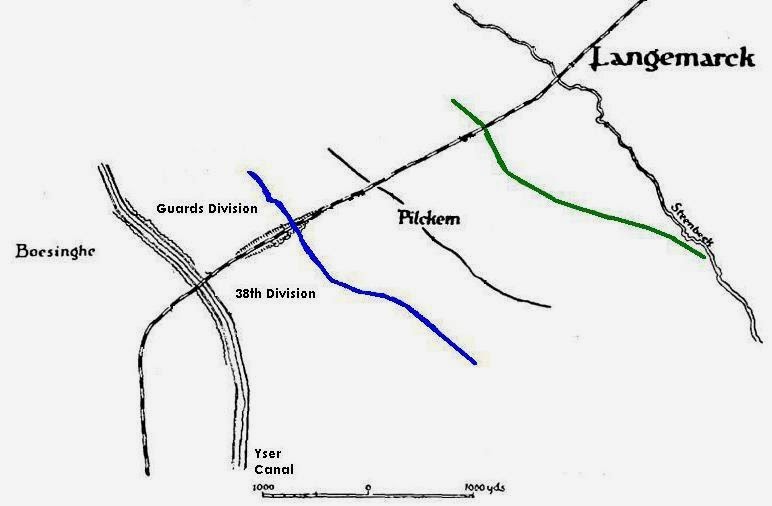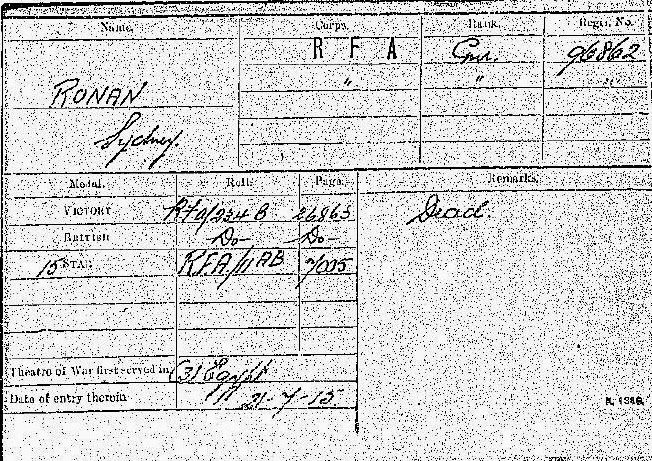Gunner Sydney Ronan, Royal Field Artillery, Service No. 96862
Sydney Ronan was the son of William McEvoy Ronan and Frances Lockett, who married at Manchester Cathedral on 14 January 1866. Sydney was born on 24 Jan 1889 at 16 Woden Street, Salford, and christened on 20 February 1889 at St. Bartholomew's Church. He was the youngest of nine children. In 1911, the family lived in Pendleton, but later moved to the Weaste area of Salford, residing at 98 Stowell Street, which ran parallel to Eccles New Road. Sydney was unmarried, and worked as a carter for Williams Cartage Ltd from their nearby Salford Docks office.[1]
 |
| Gunner Sydney Ronan |
Sydney joined the Royal Field Artillery (RFA) in 1914, and received his training probably at No.2 Camp in Preston, Lancashire. His service number was 96862. He was assigned to the LIV Brigade RFA, under the command of the 10th (Irish) Division, which sailed from Devonport on 7 July 1915 for Egypt. The Brigade arrived at Alexandria two weeks later. Sydney's medal cards shows that he entered this theatre of war on 21 July 1915. From Egypt, the 54th Brigade moved to Mudros, on the island of Lemnos, which was being used as a forward base for the ill-fated Gallipoli Campaign. At Mudros, Sydney appears to have been transferred to the LVII (Howitzer) Brigade, which was sent to Suvla Bay on 16 August 1915, and then on to Cape Helles on 16 December 1915. They were eventually evacuated on 30-31 December 1915, and the remnants of A & D Batteries were absorbed into the CXXXII (Howitzer) Brigade of the 29th Division on 2 March 1916.
The 29th Division returned to Egypt, and, on 25th February 1916, it was ordered to France. The division arrived at Marseilles during March, and were transported to the Western Front, concentrating in an area north of Amiens, and just in time for humanity's bloodiest confrontation, The Battle of the Somme. During this battle, the CXXXII (Howitzer) Brigade was broken up to repair other battered brigades, and Gunner Ronan was transferred during September 1916 to A Battery of CXXII Brigade RFA, under the command of the 38th (Welsh) Division. The 38th Division, having suffered badly during the battle for Mametz Wood (July 1916), had been placed in reserve. It did not take the field again until the Battle of Pilckem Ridge, which took place between the 31st of July and the 2nd of August, 1917. The Battle of Pilckem Ridge marks the opening round of the larger Third Battle of Ypres, more famously known as the Battle of Passchendaele.
 |
| Third Battle of Ypres Source: Battlefields of the First World War |
The Artillery Barrage
Railway whistles screamed from the trains taking up more shells, always more shells, toThis "inferno of fire" was so horrendously loud that
the very edge of the fighting lines ... the massed batteries using them as fast as they could be unloaded.
... Throughout Saturday night (28 July), heavy and continuous firing in Belgium could be heard in English southeastern coastal towns.The bombardment reached its crescendo on 31 July 1917, just before the infantry attack was due to begin at 3:50 am. Incendiary thermite shells, flaming oil drums, and gas shells were added to the deadly curtain fire.
Over the Top
The XIV Corps, under the command of the Earl of Cavan, was composed of the Guards Division and the 38th (Welsh) Division. They were placed at the northern end of the Ypres salient, and were poised to attack eastward across the Yser Canal. Their objectives were deliniated by a succession of lines: blue, black and green. Their goal was to capture the uplands of the Pilckem Ridge, with its strategic view over the Ypres Salient, and then push on to secure a bridgehead over the Steenbeek Stream.
 |
| Map: Advance to the Steenbeek |
By 5:20 am, under the protection of a creeping barrage, the infantry reached the blue line with relative ease, capturing large numbers of prisoners, stores of ammunition and trench mortars. However, with daybreak, resistance stiffened, but the division pushed on, capturing the village of Pilckem, and eventually crossing the Steenbeek at 12:30 pm. However, a German counter-attack pushed them back across the stream. During their advance, the 38th Welsh Division virtually destroyed the elite Prussian 'Cockchafers' (3rd Guards Infantry Division).
 |
| The remains of the Steenbeek |
Then, in the afternoon, it began to rain in torrents, and it didn't stop for four days and four nights. It turned the battlefield into a dangerous quagmire. This made it extremely diffucult for the artillery, whose job it was to move forward in support of the advancing troops.
 |
| British field gun mired in the mud near Pilckem Third Battle of Ypres Source: IWM Q5938 |
During the Battle of Pilckem Ridge, the German artillery was not idle, but returned heavy fire in what has been described as "the biggest artillery duel of the war". Exactly how Gunner Ronan died can only be reconstructed, since the records of the Royal Artillery were destroyed in 1940 during the London Blitz. It is most likely that Sydney was wounded in counter-battery fire during the battle, which was devastatingly intense. He died on 6 August 1917, apparently of his wounds, four days after the battle had finished. As a gunner of the CXXII RFA, he would have been firing a howitzer. The photograph below shows a 6 inch howitzer, which was taken on 16-18 August 1917, a few days after, and near to where, Sydney was killed. He was 27.
 |
| Photo of a howitzer taken near Boesinghe |
Sydney Ronan is buried at Bard Cottage Cemetery near Ypres in Belgium. (CWGC) (Find-A-Grave)
He received the 1914-15 Star, the British War Medal, and the Victory Medal.
 |
| Medal Card |
Notes
[1] Slater's Directory (Manchester, Salford) 1911
[2] Initially, the artillery alternated between a day of counter-battery work and a day of trench bombardment. The last two days before the assault was dedicated solely to counter-battery work. British Artillery on the Western Front in the First World War (p.189).




No comments:
Post a Comment